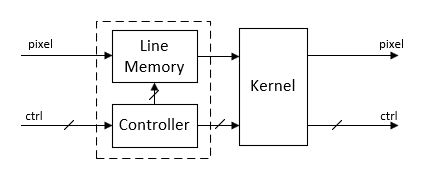Demosaic Interpolator
Construct RGB pixel data from Bayer pattern pixel stream
Libraries:
Vision HDL Toolbox /
Conversions
Description
The Demosaic Interpolator block provides a Bayer pattern interpolation filter for streaming video data. The block implements the calculations using hardware-efficient, multiplier-free algorithms for HDL code generation. You can select a low-complexity bilinear interpolation, or a moderate-complexity gradient-corrected bilinear interpolation.
When you select bilinear interpolation, the block operates on a 3-by-3 pixel window using only additions and bit shifts.
When you select gradient correction, the block operates on a 5-by-5 pixel window. The calculation is performed using bit shift, addition, and low-order canonical signed digit (CSD) multiplication.
Ports
This block uses a streaming pixel interface with a
pixelcontrol bus for frame control signals. This interface enables the
block to operate independently of image size and format. All Vision HDL Toolbox™ blocks use the same streaming interface. The block accepts and returns a scalar
pixel value and a bus that contains five control signals. The control signals indicate the
validity of each pixel and its location in the frame. To convert a frame (pixel matrix) into a
serial pixel stream and control signals, use the Frame
To Pixels block. For a full description of the interface, see Streaming Pixel Interface.
This block also supports multipixel streams. In that case, the pixel input is a vector of M-by-1 values, where M is number of pixels. The pixel output is a matrix of M-by-3 values. The M value corresponds to the Number of pixels parameter of the Frame To Pixels block, and each output pixel has three components in RGB color space.
Input
Output
Parameters
Tips
When you use a block with an internal line buffer inside an Enabled Subsystem (Simulink), the enable signal pattern must maintain the timing of the pixel stream, including the minimum blanking intervals. If the enable pattern corrupts the timing of the pixel stream, you might see partial output frames, corrupted pixel stream control signals, or mismatches between Simulink® and HDL simulation results. You may need to extend the blanking intervals to accommodate for cycles when the enable is low. For more information, see Configure Blanking Intervals.
Algorithms
References
[1] Malvar, Henrique S., Li-wei He, and Ross Cutler. “High-Quality Linear Interpolation for Demosaicing of Bayer-Patterned Color Images.” Microsoft Research, May 2004. http://research.microsoft.com/pubs/102068/Demosaicing_ICASSP04.pdf.

